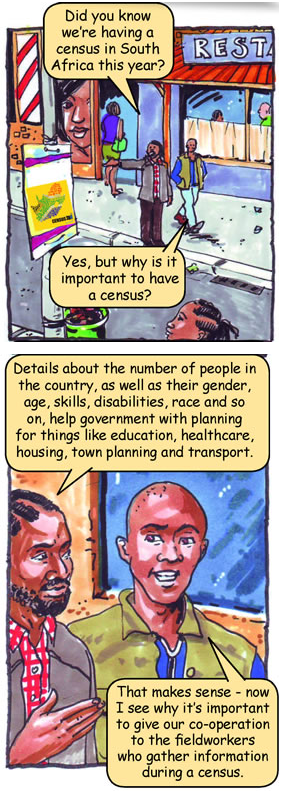Census 2011 Getting READY to be COUNTED
Census 2011 Getting READY to be COUNTED sadmin On 9 and 10 October this year, all people who find themselves inside South Africa’s borders will be counted as part of Census 2011. More than 140 000 enumerators (fieldworkers) will be visiting members of the public to gather information.
On 9 and 10 October this year, all people who find themselves inside South Africa’s borders will be counted as part of Census 2011. More than 140 000 enumerators (fieldworkers) will be visiting members of the public to gather information.
Census 2011 fieldworkers will be carrying three different questionnaires when they visit places such as townships, suburbs,
villages, rural homesteads, flats and houses on the nights of the
census.
Members of the public are urged to give their co-operation to census fieldworkers on these two nights.
First questionnaire
The main questionnaire is for households. This questionnaire will be asking questions relating to personal details such as how many people live in a household, their level of education, source of income, state of health, and whether they are employed or not.
Second questionnaire
The second questionnaire is for people who are in the process of travelling from one place to another or on their way to leave the country on the two nights of the census.
These include passengers at airports and various other ports of entry such as harbours and land border posts.
These also include tourists in hotels, people in caravan parks, and homeless people in the streets, as well as those who are travelling on the roads like truck drivers at various truck stops along their routes.
Third questionnaire
The third questionnaire is aimed at people who are in places like hospitals and prisons, as well as for students in residences, boarding
schools, and soldiers in defence force barracks.
It also includes people in police cells, shelters for the homeless, frail care centres, refugee shelters, initiation schools, monasteries, orphanages, homes for the disabled and old-age homes.
It will also be used to record details of babies born before midnight between 9 and 10 October.
– Mbulelo Baloyi
Safety measures
Safety measures have been put in place to ensure the safety of both the enumerators and the public. The 120 000 enumerators will be monitored by 30 000 supervisors, who will also report to higher management.
The public will be able to phone a central database centre to make sure the enumerators are genuine fieldworkers and not criminals posing as fieldworkers. Each enumerator will be a member of the community they serve and will be allocated a total of 120 households in a specific area. This will make it easy to trace them.
Members of the public will be able to identify Census fieldworkers by marked yellow clothing, bibs and identity cards with photographs.